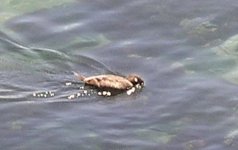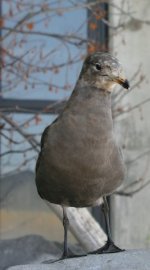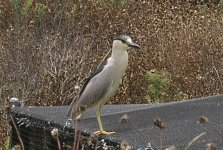Day 6: On my way to the toilets I saw a calling
Bullock's Oriole right above me. At breakfast we had a pleasure to enjoy a high-speed chase between
Brewer's Blackbirds and a
Raven. No prize for guessing who won. We decided to drive to Glacier Point and stop on the way for shorter hikes along the numerous trails around the Glacier Point Road. Our first was the Ortsander Lake Trail (not sure if the spelling is correct). We didn't have to walk far to find interesting birds. A
Green-tailed Towhee was singing atop a dead tree and a
Wilson's Warbler was energetically jumping all around us. A
»Red-shafted« Northern Flicker was seen visiting her nest. We continued to Glacier Point where we were greeted by a spectacular view and
Mountain Chickadees. On the way back we made a hike to Sentinel Dome. It was very exciting because there was still quite some snow there. On the way I managed to see a splendid male
Western Tanager. In the Visitors' Centre we found out that the Yosemite Birding Festival was under way the very weekend we were visiting. Lectures and trips were to be organized. We were on our way to El Portal (the HQ of the event) where I applied. It certainly was a good spot to apply at! As soon as I signed the papers a
Golden Eagle was sighted. I've seen them at home, but every time I see it, I'm delighted. I had applied for the trip in Western Yosemite Valley.
Day 7: The rally point was at the Bridalveil Fall. First of all we inspected a nearby creek and spotted an
American Dipper. It's no match to our Dipper in appearance, but still an intriguing bird. We continued through a small grove, in which we heard and later saw a
Black-throated Gray Warbler, the
Nashville Warbler didn't show up though. We crossed the road and came to a more open type of forest. There we had good views of an
Acorn Woodpecker and a noisy group of
Chestnut-backed Chickadees. We also had a few good views of Gilbert's Skinks, all of them were immature. A
Warbling Vireo was doing all he possibly could to drive a
Steller's Jay away from his nest, he eventually succeeded. A
Western Wood Peewee was on the hunt,
»Audobon's« Yellow-rumped warblers were quite numerous. We moved to a part of forest closer to the river where the soil was noticably wetter and the air more humid. I went for a short walk in the Merced river and it was neither cold nor wet (just because I was wearing shoes of course

).A
Black-headed Grosbeak was heard singing in the distance, and I was on the verge of developing Vireo-neck because of a
Cassin's Vireo high in the trees. We decided to go back and make a short walk by the fall in order to try and find a
Canyon Wren which we managed to hear in the end. It was time to go and we decided to visit the Mariposa Grove in the afternoon. We had great lunch in a colonial style hotel in Wawona and then a shuttle bus took us to the Grove. I could hear many birds singing and calling, but with no one help me out at hand, they remained unidentified. One of the better surprises awaited me just around the corner. I was attracted by a woodpecker sound. I couldn't call it drumming because it was very quiet and slow, but a
White-headed Woodpecker soon showed up. It was obviously feeding on a ponderosa pine. I admired this bird for a while and after that we moved on. The only other bird I saw there was a
Red-breasted Nuthatch. We returned to our and attended a lecture on the raptors of California in the evening.








